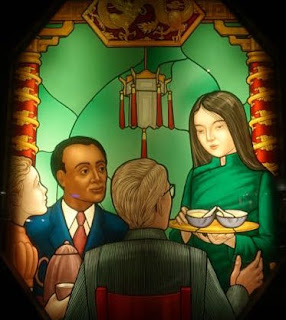You know the ones, they are set in the the tiny slits in the brick wall facing on to the street.
They depict a flower store, people eating around a table, a pharmacy.
Well, enjoy them now because they are about to disappear. The Quest building that has housed them for the past two and a half decades is slated for demolition later this year to make room for the Mass + Main project, and that means Cambridge will lose one of its most interesting and bizarre treasures, one that has greeted pedestrians and prompted questions in the square for a generation.
 |
| The Quest Building, Central Square, soon to come down |
The windows owe their existence to two men, Lyn Hovey and the late Dr. Richard Fennell. Hovey is the stained glass artist who created them. Fennell was an Cambridge entrepreneur and businessman who commissioned and paid for them.
 |
| Lyn Hovey, creator |
In an effort to address it, Fennell commissioned Hovey to create the windows, a gift of public art for the community paid out of Fennell's own pocket. This was in the early 1990s and Hovey remembers the decision as a bold and generous one, noting that this wasn't a "1% for Art" effort. This was a privately funded commitment by a philanthropist enlivening the public realm.
Fennell as patron put no restrictions on Hovey. The themes depicted in the glass would be Hovey's to decide. So using his knowledge of the neighborhood that he had gathered from his years of living nearby, he set out to convey the variety of experience in Central Square, the local florist, the soda fountain. Hovey remembered the strong West Indian presence in the Square at the time and the stained glass also depicts the diversity of the multi-cultural community in Central. However, these are not actual places that existed. The come from Hovey's imagination alone.
By the time he started on this project, the Cleveland native was no stranger to Cambridge, having arrived in 1965 to work in the Burnham Studios in Boston. He decided in 1972 to branch out on his own and opened Lyn Hovey Studios at Concord Avenue and Appleton Street in Cambridge. Though he was in this Concord Avenue shop for many years, the windows that now adorn Central Square were actually created in his South Boston studio on Drydock Avenue.
 |
| The shop in Cambridge where Hovey had his studio for many years |
So, what will happen to these pieces next? Hovey was very clear that these windows are works of art and of value. Religious stained glass interestingly but understandably is difficult to resell because it is often so specific to the tastes of the congregation at the time of its creation. Secular stained glass doesn't have the same constraint. Hovey reiterated that these frames cost a lot to make and they could be sold for a lot too. Most of all, he felt strongly they should not end up in a scrap heap somewhere.
That will be up to the Twining development team when they decide their fate at the time of the building's demolition. The Twining team is aware of the windows and have indicated that they will not be thrown out. These wonderful, quirky pieces have adorned and enlivened Central Square in ways both amusing and mysterious. A small subchapter in Cambridge is about to close, and it will be interesting to see how the next one begins.
The windows ...
[Note/correction: The original version of this article reported that these windows were fabricated in Lyn Hovey's studio on Concord Avenue in Cambridge. That is incorrect. The windows were fabricated in his studio on Drydock Avenue in South Boston. The text has been corrected to reflect this.]



















